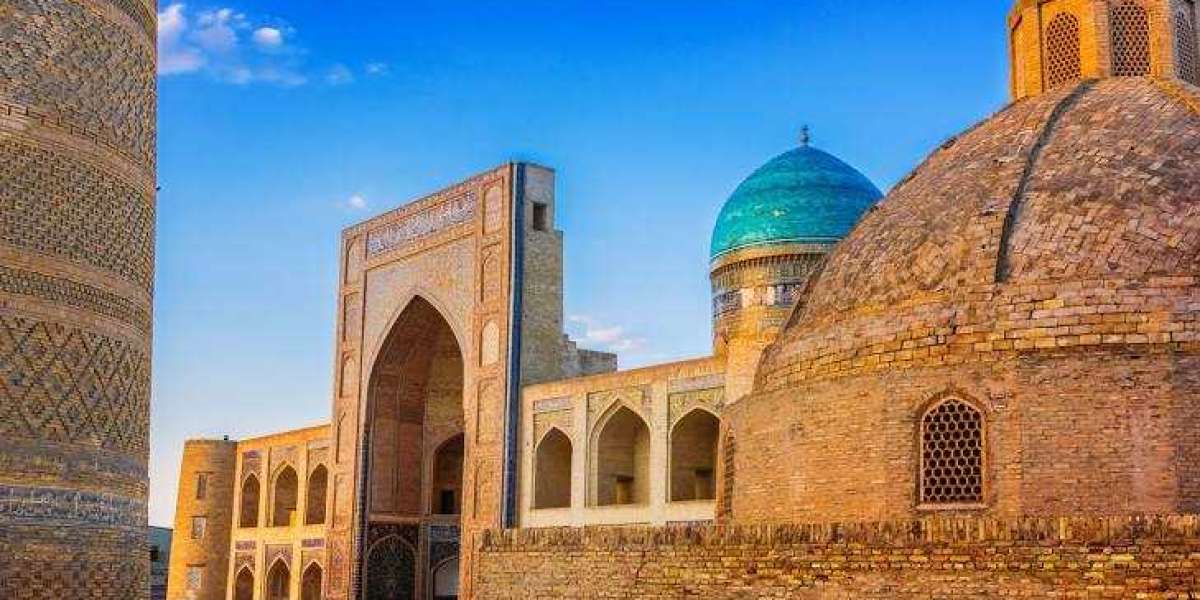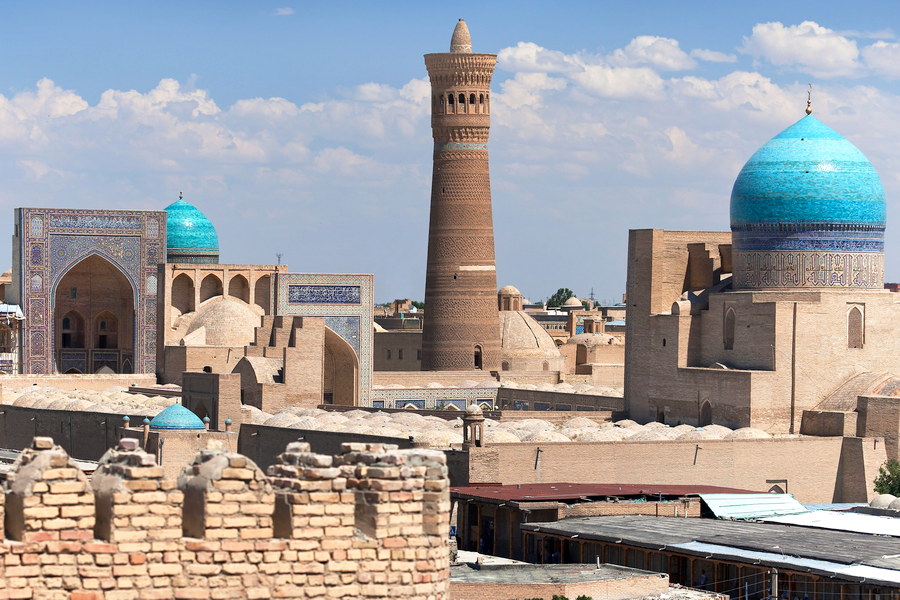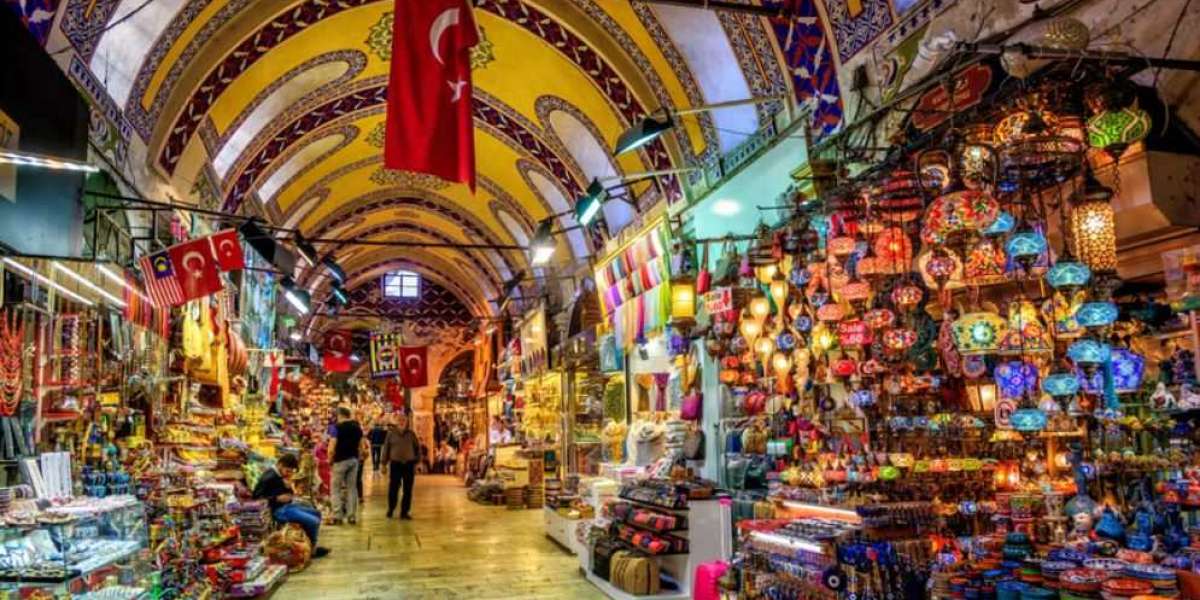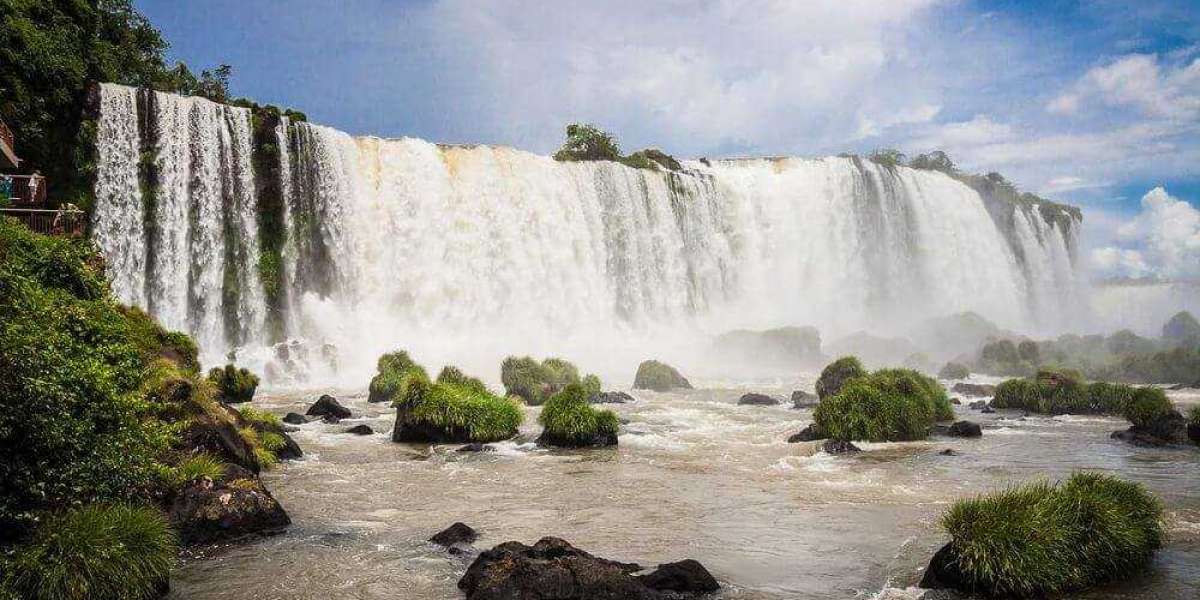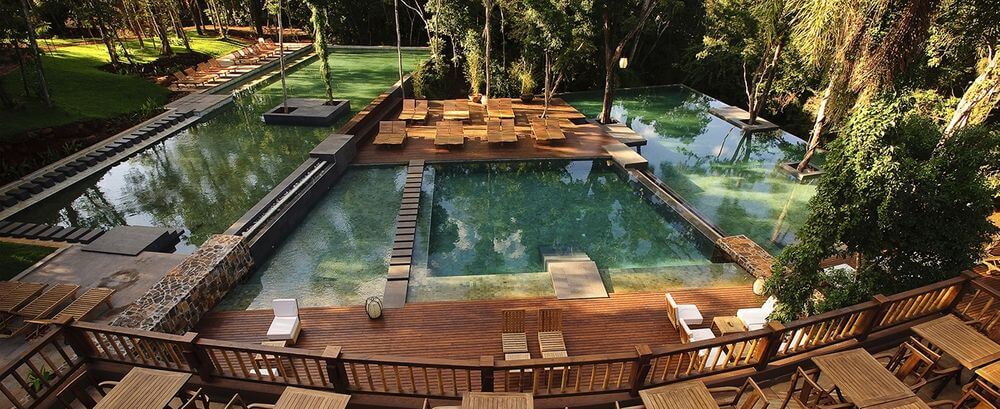Top things to do in Uzbekistan
Tours, Attractions and Things To Do in Bukhara
Bukhara Travel Guide
Bukhara, situated in Uzbekistan, is among the oldest cities in Central Asia. In days gone by, the renowned Silk Road caravans traversed through this historic city. The ancient section of Bukhara has been recognized as a UNESCO World Heritage Site, attracting thousands of tourists from across the globe each year.
Today, Bukhara is a vibrant, thriving city with a population exceeding 275,000 residents.
Bukhara Tours
Bukhara tours invite travelers on a journey through time, revealing one of the most well-preserved medieval cities in Central Asia. With its dazzling array of mosques, madrasahs, and mausoleums, these tours offer a mesmerizing window into the region's past, from the awe-inspiring Ark fortress to the intricate design of the Mir-i Arab Madrasah.
Before beginning your adventure, enrich your experience by familiarizing yourself with the profound history and enchanting tales of Bukhara.
History of Bukhara
Scholars believe that Bukhara was established around the middle of the first millennium BC. During archaeological excavations within the city, artifacts such as pottery, jewelry, and remnants of 5th-century BC structures have been uncovered.
The city of Bukhara was first mentioned between the 4th and 5th centuries on coins bearing its name. In the 7th century, the Chinese scholar and translator Xuanzang wrote about the city. The name "Bukhara" is derived from the Old Uighur language, meaning "prayer house" or "temple." However, various sources have referred to the city by different names, including Nyumi, Bukho, Buhe, Bukhala, Bumiskat, Fuho, and Anxi.
Throughout its history, Bukhara has been a coveted city for many rulers, changing hands from one conqueror to another. In pre-Islamic times, it served as a cultural hub for Central Asia.
During the 9th and 10th centuries, Bukhara became the capital of the Samanid Empire. Renowned figures, such as Abu Ali Ibn Sina, Abu Abdullah Jafar Ibn Muhammad Rudaki, Omar Khayyam, and others, lived and worked within its borders.
In the ensuing centuries, architectural brilliance flourished in Bukhara even as it ceased to be the capital. Numerous medieval structures have been preserved to this day. Under the reign of Tamerlane (Amir Timur), Bukhara began to emerge as a religious center, earning the moniker Bukhoroi Sharif, or Holy Bukhara.
Following the 1917 revolution, many historical edifices in Bukhara were demolished. By 1925, the city became part of the Uzbek SSR.
In 2020, the Organization of the Islamic World for Education, Science, and Culture designated Bukhara as the capital of Islamic culture.
Things To Do in Bukhara
Landmarks and Attractions in Bukhara
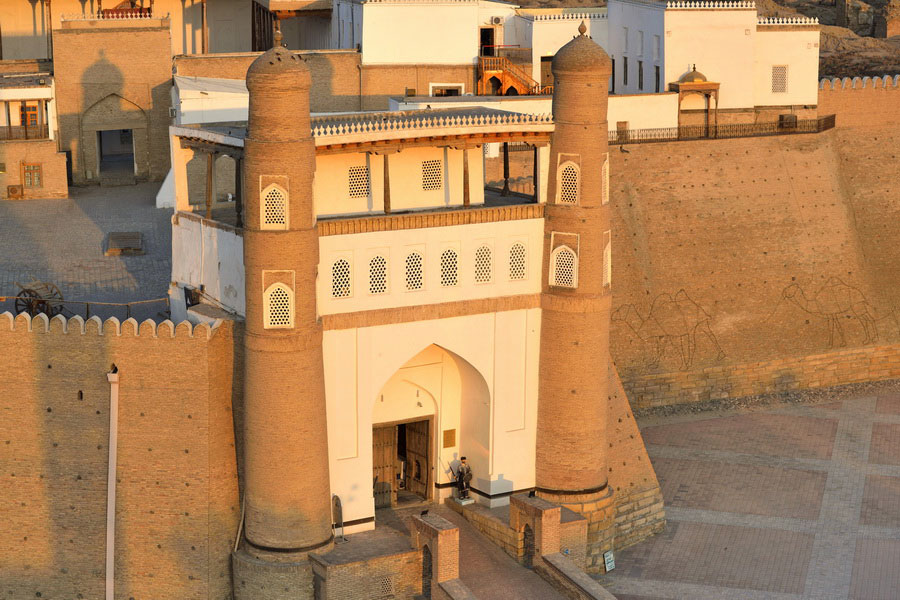
The ancient Ark fortress is one of the architectural symbols of Bukhara and the oldest monument of the city. This citadel is synonymous with impregnability and grandeur. Documentarily the fortress existed already in V century, and archeological excavations have confirmed that on this territory there was a defensive construction in IV century B.C. In VIII century the first city mosque was constructed here. On the territory of the citadel there was a palace, reception halls, hotels, library, mint, bath, prison and much more. Ibn Sino, Omar Khayyam and Rudaki all worked within the walls of the Arch. Today the Arch is a museum-reserve, where you can see how the rulers of the Middle Ages lived and the archaeological finds of scholars, as well as admire the oriental architecture.
Registan Square is not only in Samarkand. This square, the name of which is translated as "sandy place", is located near the Ark fortress. In the Middle Ages there were trading rows as well as administrative buildings and mosques.
Bolo Hauz is the only surviving complex of the Registan. It consists of mosque, minaret and hauz (pond). Mosque and hauz were built in 1712. After 200 years, a minaret was built next to the mosque.
Samanid Mausoleum serves as the burial site for the Samanid dynasty, who once ruled Bukhara. Constructed in the late 9th and early 10th centuries, it is the only surviving structure from that era. In 1993, the mausoleum was added to the UNESCO World Heritage List. Remarkably, the brick building has remained virtually unchanged for a thousand years.
Poi-Kalyan (Po-i-Kalan, or Poi Kalan) is an architectural ensemble located in the heart of Bukhara. Its name translates to "foot of the Great" or "foot of the Kalyan Minaret." The ensemble comprises the Kalyan Minaret (Kalon) at its center, the Kalyan Mosque and the Miri-Arab madrasa facing each other, and the Amir Alim-khan madrasa.
Built in 1127, the Kalyan Minaret is a towering brick structure designed for Muslim clergymen to call the faithful to prayer from its summit. Standing at 46.5 meters tall, the minaret tapers upward from its 30.43-meter base. Its walls are adorned with geometric patterns and religious inscriptions.
Kalyan Mosque serves as Bukhara's primary Friday mosque, with the capacity to accommodate 12,000 worshippers simultaneously. Constructed in 1514, the current building replaced the original mosque that was destroyed by Genghis Khan's forces. The mosque features intricate decorations both on its exterior and interior.
Miri-Arab is a madrasah, an educational institution established in 1536. Until 1920, it was considered one of the finest in Central Asia, with many notable individuals teaching and studying within its walls. For instance, the first mufti of Ufa, Muhammedjan Husain, and the first mufti of Russian Muslims, Galimdzhan Barudi, were both graduates of this esteemed institution. However, following the 1917 revolution, the madrasah was closed and its clergy repressed. Believers campaigned for the resumption of educational activities after the Second World War, and between 1946-1956 and 1961-1989, the Miri-Arab madrasah was the only functioning madrasah in the entire Soviet Union.
Part of the Poi-Kalyan complex, the Amir Alim-khan Madrasa was founded in 1915. It was built using funds provided by Seyid Alim-khan, the last Emir of Bukhara. After all religious educational institutions were shuttered in 1924, the madrasah housed a library.
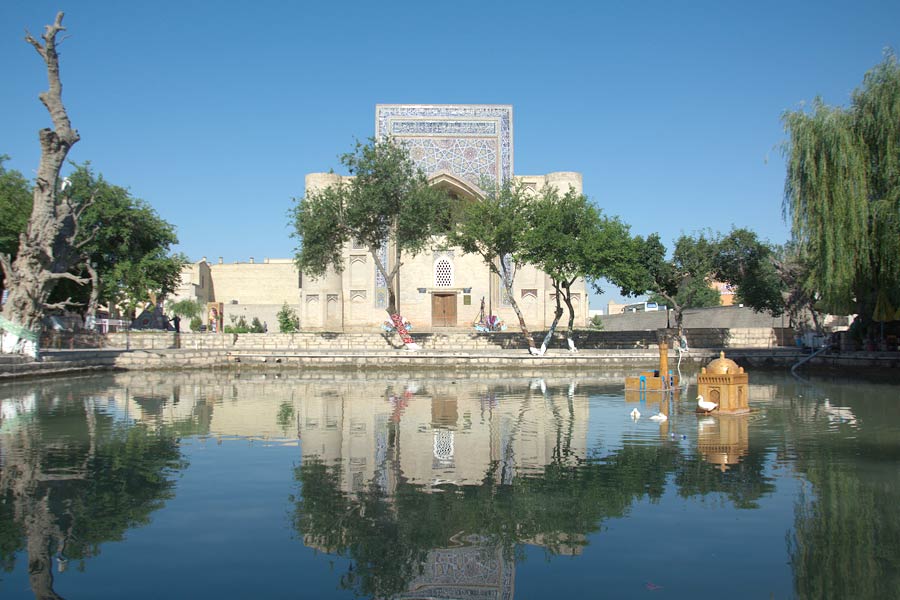
Lyabi-Hauz is one of the most popular spots in Bukhara, featuring a pond ("hauz" in Uzbek translates to "artificial water body"). Since the 16th century, Lyabi-Hauz has attracted numerous residents, as watermen once collected water from it for drinking and street watering purposes. Trade shops and teahouses were also situated near the pond. Today, as it has been for centuries, Lyabi-Hauz remains a central location in Bukhara. A monument dedicated to the renowned folklore character Hoja Nasreddin can be found nearby.
Founded in 1569 and situated close to the Lyabi-Hauz reservoir, Kukeldash Madrasah is currently the largest spiritual educational institution in Central Asia. Within its two-story structure, you can also find artisan workshops and souvenir shops.
Built in 1623, Nadir Divan-begi Madrasah is another noteworthy site located near Labi-Hauz. Initially serving as a caravanserai for weary travelers, the building was later repurposed as a religious school. Interestingly, the madrasah is adorned with ornamental features uncommon for Muslim structures, such as depictions of birds and animals.
Chashma-Ayub Mausoleum (Chashma Ayub) is regarded as a sacred site. It features a well with holy water, which, according to legend, was created by the biblical figure Job, referenced in the Old Testament. As the people suffered from thirst, Job struck the ground with a staff, causing a spring to gush forth. Historical records indicate that the well was constructed in 1380. Revered by both Muslims and Christians, this site has been visited by notable figures such as His Holiness Patriarch Kirill of Moscow and All Russia in 2017. The holy water, believed to cure many ailments, continues to flow here.
Built in 1652, the Abdulaziz Khan Madrasah is an architectural monument and a masterpiece of Bukhara architecture. While architects may identify various flaws or even instances of poor taste in its design, the building's decorative elements are sure to captivate onlookers.
Situated near Bukhara, the Sitorai Mokhi-Khosa Palace was once the country residence of the last Emir of Bukhara, Seyid Alim-khan. Constructed in 1918, the well-preserved building now houses a museum of arts and crafts. Visitors are drawn not only to the museum's collection but also to the palace's exquisite interior design.
Located in a suburb of Bukhara, the Bahauddin Naqshbandi Memorial Complex comprises a mausoleum, two mosques, a minaret, and a madrasa. Naqshbandi, a renowned 14th-century theologian, founded the Naqshbandiya Sufi order and served as the spiritual guide to Tamerlane (Amir Timur). He completed the pilgrimage to Mecca 32 times. Muslims regard this site as the Mecca of Central Asia, attracting visitors from the CIS countries and other nations worldwide. It is believed that walking from Bukhara to the Naqshbandi mausoleum three times holds the same merit as completing the hajj.
Constructed in the late 19th century by the famed architect Alexey Benua, the Palace of the Emir of Bukhara in Kagan showcases a unique blend of three architectural styles: Neo-Moorish, Empire, and Baroque. Arabic motifs are also intricately interwoven into the predominantly European style.
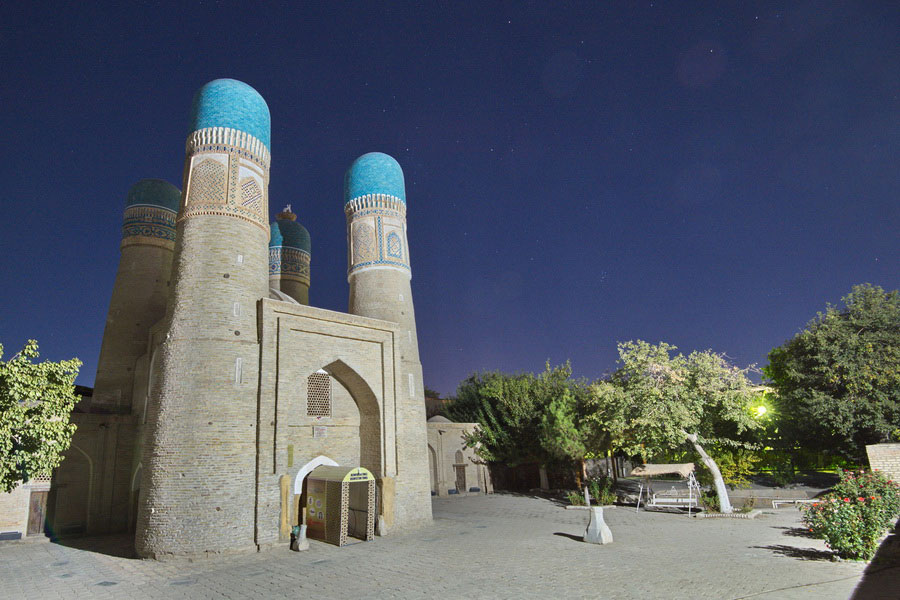
Chor Minor, the Khalifa Niyozkuli Madrasah, was built in 1806. Its name translates to "four minarets," referencing the four identical minarets adorning the building, each topped with a blue dome. Interestingly, each minaret features a distinct decorative style. The designs are often interpreted as symbols of four religions, including the Christian fish, the cross, and the Buddhist prayer wheels.
Chor-Bakr, a necropolis situated near Bukhara, is considered the largest in Central Asia. Known as the city of the dead, it was constructed in the 16th century. Many prominent individuals are interred here, such as Abu Bakr Saad, a descendant of the Prophet Muhammad, who is believed to be among the first buried at the site.
Bukhara also boasts numerous other points of interest, including the Khoja Gaukushon complex, Magoki-Attori Mosque, Mausoleum of Imam Abu Khavs Kabir, Khanaka Mosque of Khoja Zainuddin, medieval baths, and much more.
Bukhara Museums
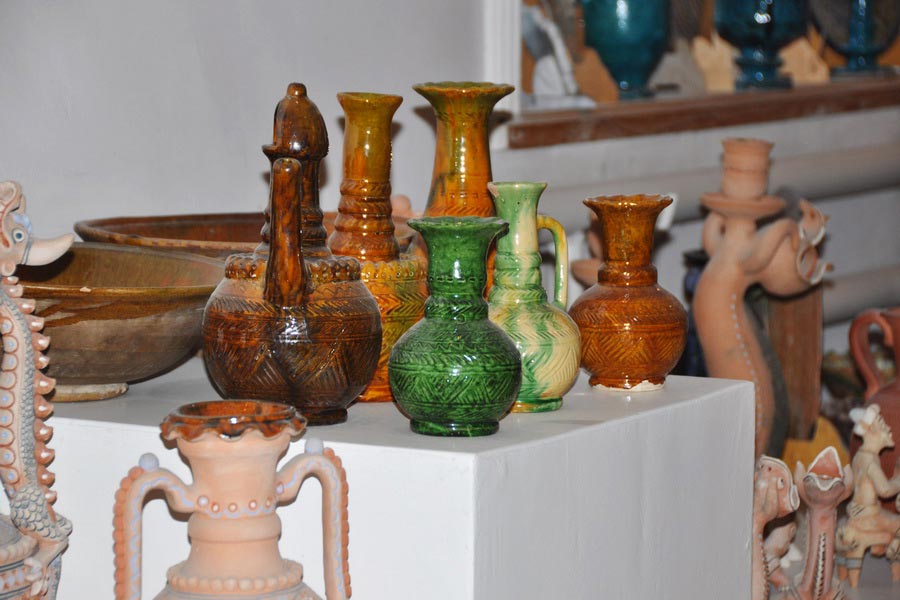
Bukhara is a city of museums, with numerous fascinating collections to explore.
Bukhara State Architectural Art Museum-Preserve, established in 1922, boasts hundreds of exhibits, including documents, photographs, household items, coins, weapons, paintings, sculptures, books, ceramics, jewelry, fabrics, and much more.
Museum of Fine Arts features paintings, graphic art, and sculptures, with the oldest exhibits dating back to the 1st century BC. It also houses fragments of decor from the 6th-7th centuries, as well as works by contemporary artists.
Frequented by visitors, the Faizullah Khojaev House-Museum is situated in the historic Goziyon quarter. Khojaev was a prominent figure who advocated for improving the lives of people in the Bukhara Emirate. He was a leader of the Jadids who was executed in the 1930s. The house-museum displays his personal belongings, documents, photographs, and collections of utensils, furniture, and weapons.
Established in the 1990s, the History Museum of Restoration of Architectural Monuments of Bukhara focuses on the extensive restoration work undertaken in the historical part of Bukhara during the 20th century.
Museum of Carpet Weaving History, founded in 1991, showcases silk and woolen carpets from the 18th to the 21st centuries, originating from Uzbekistan, Iran, Turkmenistan, and Kazakhstan.
The Blacksmith History Forge Museum, situated in the Kuluta caravanserai, offers a glimpse into the history of blacksmithing. Visitors can observe the work of 18th to 21st-century blacksmiths and even participate in creating ironwork themselves.
Workshop-museum of Uzbek puppets is sure to captivate both children and adults. Learn about the doll-making process, marvel at the pumpkin dolls on display, and even purchase a doll as a souvenir or gift.
Located near Bukhara, Gijduvan Ceramics Museum showcases the work of both modern and traditional ceramic masters. The museum features pieces from a family dynasty spanning six generations in the craft.
Romitan Museum of Local History, also near Bukhara, is housed in what was once the winter residence of the Emir of Bukhara. The museum provides insight into Romitan's history and its notable residents.
Located 30 kilometers from Bukhara in the village of Afshana the Abu Ali Ibn Sina Memorial Museum was established in 1980 to commemorate the 1000th anniversary of the renowned physician and scholar, Avicenna. Visitors can learn about his life and scientific contributions at this museum.
Bukhara Theatres
The Bukhara Sadriddin Aini Music and Drama Theater, situated in Mirzo Ulugbek Park, was established in 1921. The theater stages performances in the Uzbek language, drawing from the works of Uzbek classics.
Additionally, Bukhara is home to a puppet theater and summer stages, where local and visiting artists showcase their talents during city festivals.
Entertainment, Parks, and Shopping in Bukhara
Bukhara is a tourist-oriented city, with most attractions clustered around the primary points of interest.
Parks in Bukhara
Although there aren't many parks in the warm climate of Bukhara, the ones that do exist tend to be bustling with activity. Mirzo Ulugbek Park of Culture and Recreation is the most popular, featuring numerous trees, benches, and attractions for children.
Samanid Park of Culture and Recreation is another favorite spot for families with children. Though small, it offers a cozy atmosphere and is located near the central market.
Adjacent to the city administration building (khokimiat), there are two modest parks where retirees and parents with strollers can be found taking leisurely strolls.
A petite park can also be found near the monument to Khoja Nasreddin.
Shopping in Bukhara
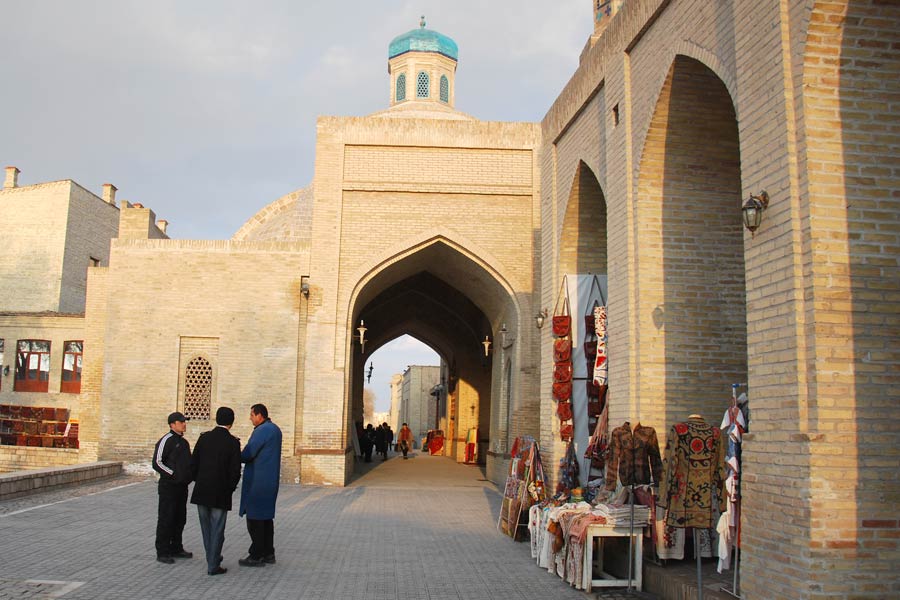
To experience the enticing scents of fresh fruits, delectable sweets, and local culture, head to Buhoro Dehqon Bozori.
For national souvenirs, visit artisan shops in the markets, the Trading Domes of Bukhara, Davron Miniatures Art Gallery, or stalls near popular attractions. Bukhara is renowned for its hereditary craftsmen who create knives, daggers, ceramics, and silver jewelry.
For clothing purchases and family-friendly outings, consider visiting Chinor Mall and Minor.
Food in Bukhara
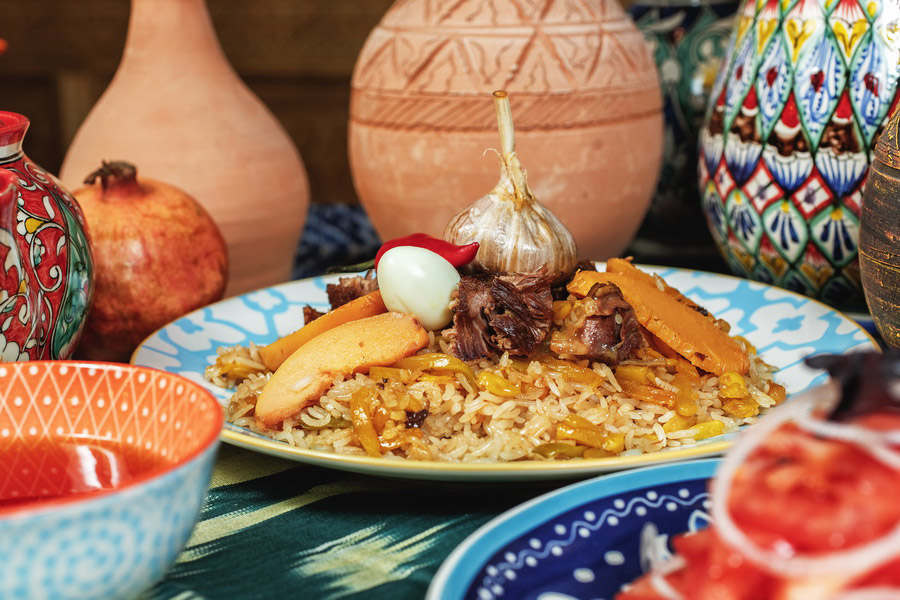
There are numerous dining options in Bukhara, both in the old center and on the outskirts of the city.
Uzbek Cuisine
The most popular Uzbek dish, plov, can be found at any establishment serving national cuisine. The most delicious plov is said to be prepared at the "Labi hovuz" restaurant. Other Uzbek dishes can be enjoyed at Adras, The Plov, Temir's, Shafran, Ismoil, Old Bukhara restaurants, Xo'ja Nasreddin cafe, and Sham Chaikhana.
Vegetarian Options
While there are no specific vegetarian establishments in Bukhara, meat-free dishes can be found at cafes and restaurants serving Uzbek and Asian cuisine.
Coffee Shops and Bakeries
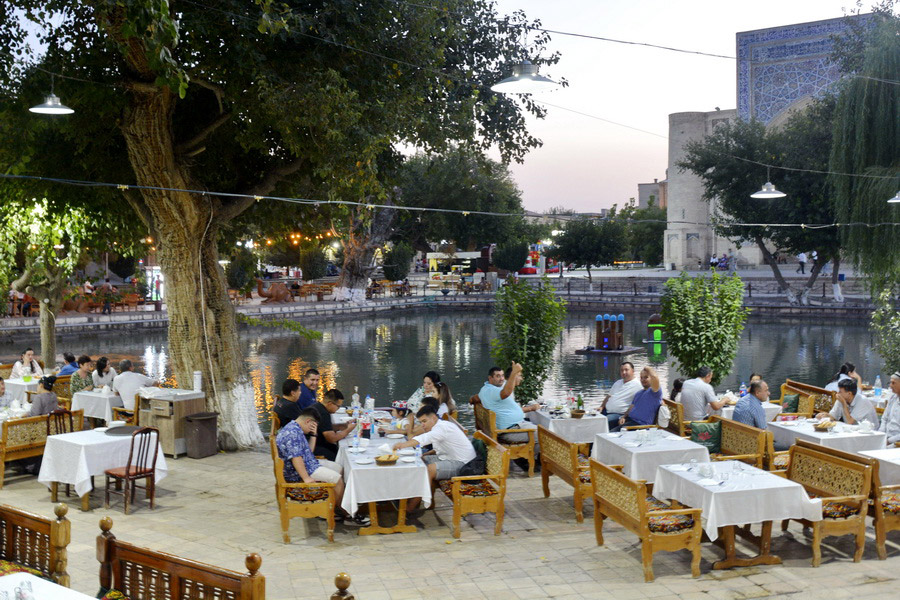
There aren't many coffee shops in Bukhara, but those available are mostly located in the central part of the city. Quality coffee can be found at CoffeeShop, Magic Coffee, Bella Italia, TeaCoffee, and Lampa Alladina.
For fresh pastries, visit Bakery Chief and TeaCoffee.
Transportation in Bukhara
Bukhara has a well-developed public transport system.
Buses
The city has over 30 bus routes, with schedules varying between 06:00 and 21:00, depending on the route. The average wait time for a bus is around 15-20 minutes.
Route taxis
Many Bukhara residents use route taxi. While there are more of them than buses, their schedules are difficult to predict.
Taxis
You can order a taxi through the Yoko Taxi mobile app (only available in Bukhara) or by calling a taxi center. Many people also hail taxis on the street and arrange rides with "private drivers."
Car Rentals
Car rental options in Bukhara are limited. There are a few private car rental companies in the city where you can rent standard and business-class cars.
How to Get to Bukhara
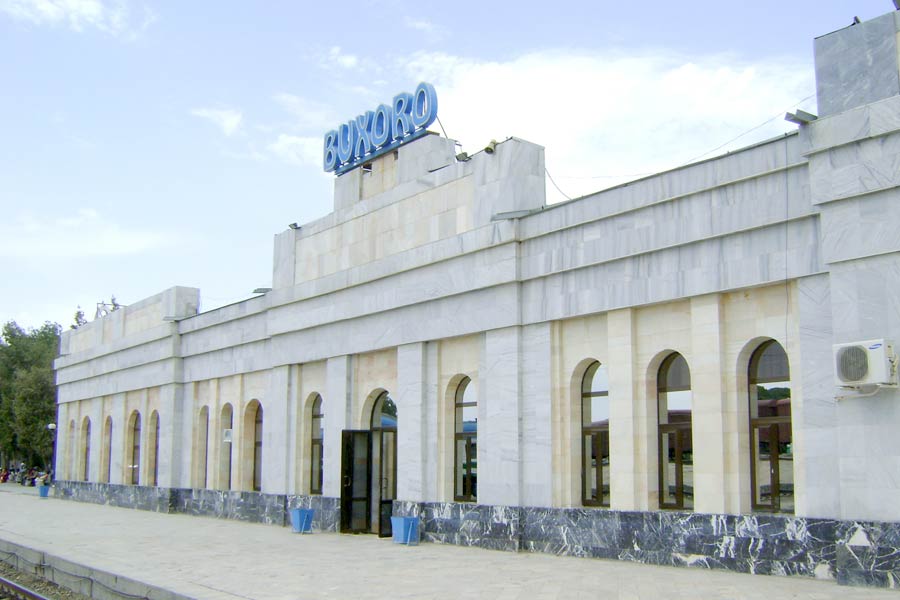
The most convenient way to reach Bukhara is by plane. Bukhara has an international airport serviced by UTair, Azimut, Rossiya, Pobeda, Red Wings, Turkish Airlines, and Uzbekistan Airways. Flights are available from Moscow, St. Petersburg, Istanbul, Yekaterinburg, Makhachkala, Zhukovsky, and Tashkent.
Trains from many cities in Uzbekistan also travel to Bukhara. High-speed train "Afrosiab" connects Tashkent and Samarkand to Bukhara. Note that the railway station is located 15 kilometers from Bukhara, in the small town of Kagan.
Additionally, you can reach Bukhara by bus or private car from various parts of Uzbekistan.
Languages Spoken in Bukhara
Most residents of Bukhara speak Uzbek, the official language of Uzbekistan. Many people also speak Russian, a common language for interethnic communication. English is less widely spoken, but in tourist areas and hotels, you may find people who can communicate in English.
Currency in Bukhara
The national currency of Uzbekistan is the Sum, and all payments in Bukhara are made in this currency. Some places accept international Visa and MasterCard payments, but it's advisable to carry cash. The most popular foreign currencies are the US dollar, followed by the Euro, and then the Russian ruble. Currency exchange is available at any bank branch.
Safety in Bukhara
Bukhara is a relatively safe city with a significant police presence. You can comfortably move around the city during the day and at night. However, always be mindful of your belongings and adhere to basic safety rules.
Turkish Grand Bazaar
Overview
It harbours over 4,000 shops, lined along 62 covered lanes that sell everything from apparel and home decor to edibles and items specific to Turkish culture and cuisine. It is also considered as one of the very first shopping malls in the world and was once a booming hub and center of the world’s trade and commerce.
The world-known bazaar is associated with a rich background of history in terms of its conception. The first structure of the bazaar, Cevahir Bedesten was ordered to be built by Sultan Mehmed II for the sole purpose of trading of textiles and jewels, in order to collect income for Hagia Sophia.
In the present day, Grand Bazaar epitomises the Turkish architecture at its best and is one of the most appealing tourist spots Istanbul. It’s enormous structure is an eye-catching edifice in itself, reeling in people’s attention and curiosity from around the world.
Exploring the market through its many lanes serves as an experience that can only be regarded as unique, pertaining to its chic boutiques, range of shopping items and the massive size and variety it offers. The bazaar is as gigantic as a labyrinth, which is what astounds first-time visitors and holds their intrigue in every way.
The market remains open from 10 AM to 7 PM and stays closed on Sunday. It sells a variety of items, from carpets and ceramic items to hammam soaps and traditional confections. The magical Turkish lamps and jewellery also make a good part of the items sold at the shops here. Grand Bazaar has been one of the primary areas of attraction for tourists and continues to be so.
How To Reach

The distance between Istanbul Airport and Grand Bazaar is about 47 kms and takes about 50 minutes to reach by road. One can reach the bazaar from the airport using other means of transport too. This would require you to take the metro from the airport till Zeytinburnu and then catch a tram from Beyazit to the Grand Bazaar.
Best Time To Visit

Fall, from the months of December to February are ideally the best time to visit Grand Bazaar to explore and buy from the various shops available there, since this is when one can get good bargains and deals with lesser crowd present.
Summer, on the other hand, sees a surge of crowd from the months of June to October, since this is the ideal vacation period for many and a peak holiday season. However, one can also have a decent experience with a moderate crowd in the later part of April.
The Grand Bazaar remains open from 9 AM to 7 PM and is closed on Sundays. The best time to visit the covered market is in the morning or any time before 5 PM. This is the time when it is less crowded and visitors can indulge in shopping, exploring the market with ease.
Essential Information

Location: Grand Bazaar is situated in Istanbul, in the district of Faith. It stretches between the west to the east, roughly between the mosques of Beyazit and Nuruosmaniye.
Distance from Istanbul Airport to Grand Bazaar: The bazaar is about 47 kms away from the airport and can be reached easily either by road, in a car or a hired taxi, or via the metro and tram.
History of Grand Bazaar

Bearing rich historical significance more than it stands as a centre of trade and commerce, Grand Bazaar is the oldest and the first shopping malls and bazaars of the world. Its existence, architecture and current stature in the world is the grand aftermath of substantial instances in the country’s ancient past.
Over the centuries, the covered market and the world’s most famous shopping spots has evolved in various aspects and now stands to be what it is today. This grand shopping structure that reels in visitors everyday from across the world, came into being in the 15th century.
Its very initial structure was constructed under the command of Sultan Mehmed II, who essentially ordered the erection of a stone Bedesten, that is a domed building, a covered bazaar. This market was ideally conceptualized for the trading of textiles and jewels and to assemble funds for the Ayasofya mosque, Hagia Sophia.
The bazaar, named Cevahir reached its completion by 1460 while the second structure, Sandal was created some years later. These two Bedesten then became the centre of commerce and trade in Istanbul and soon began to be recognised globally.
Soon Cevahir and Sandal were accompanied by other shops and stalls that began to grow around these structures. Later, they were also domed over and became the core of commercial life. The bazaar then morphed into a magnificent centre of buzz and business with a school, mosque, tomb, 20 inns and 16 fountains augmenting its value.
Though, a major part of these edifices were damaged as a result of earthquakes and fires, including the enormous earthquake in 1894. This period was a low point for the entire market, when it suffered a setback. However, it was soon reconstructed to its current state with the aid of Ottoman Sultan Abdulhamid II.
Architecture of Grand Bazaar

Resembling a massive maze, the Grand Bazaar aesthetic relays archaism and grandiose in certain aspects. The labyrinth, like a covered market of over 60 streets and 4,000 shops, attracts visitors from across the world due to its architectural and historical value.
The entire bazaar spreads across 30,700 thousand square metre and strikes across as a prominent edifice, boasting of its deep relevance of design and commerce. The large shopping bazaar displays a colourful structure at first sight, which exhibits striking design elements and intricate aesthetics.
This is the Cevahir Bedesten, marked by its monumental architectural significance and divided into fifteen separate sections. These sections are furthermore represented by domes, with the detailing of their interiors exhibiting the culture and traditionalism of Istanbul.
Sandal Bedesten, on the other hand was constructed in such a way that it would accommodate fifty other domes enclosing it. These two Bedesten, Cevahir and Sandal make for the primary bazaars of the Grand Bazaar, epitomizing the Turkish architecture and design in domes, in the rawest and realest form.
Bearing thick inner safe irons, these two bazaars are identified as the citadels of the bazaar. This is where traders would store their valuable documents and jewellery. In a nutshell, the architectural aesthetic and design of Grand Bazaar is no less than a true Turkish masterpiece.
Grand Bazaar Shopping Etiquettes

With over 4,000 shops and 60 lanes to explore, the Grand Bazaar is no less than a maze, where you can explore, soak in the Turkish culture as a result of some tête-à-tête with the sellers, get offered some Turkish tea and of course, shop.
Whether you’re new to bargaining or are simply inclined towards passing up the idea of it due to lack of knowledge, here are some tips on shopping etiquettes at Grand Bazaar. First and foremost, don’t hesitate to put forward your quote of the bargained price on what you wish to buy.
Secondarily, feel free to walk around, explore various shops and options and take your time to come down to your final product to purchase. Making the most of Grand Bazaar is certainly not an hour-long affair. Have some extra spare hours to be able to stop by every other shop, see what you wish to buy, compare products and prices and then invest.
Moreover, it is important to know that drinking a cup of tea at shops is routine and doesn’t compel you to necessarily shop from them. One can take their time, move around, and shop wisely from wherever they wish to.
Things to Buy at Istanbul's Grand Bazaar

- Istanbul’s Grand Bazaar has been a substantial centre of trade and commerce since its inception. Naturally, it has a horde of items to offer, from exemplary jewellery and textiles to carpets and hammam soaps. Although the covered market covers all the necessities and essentials of a household, there are certain items peculiar to the Turkish culture and traditions that are best shopped from here.
- One such element is the ceramic collection; iznik bowls and Turkish ceramic like plats, mugs, vases, ashtrays and hanging ornaments are some popular boys at the Bazaar. They represent the stunning ceramic tiles of the Turkish monuments.
- Beautiful, colourful ornamental Turkish lamps easily rank as one of the best sellers at Grand Bazaar. These intricate, glass lamps make for that statement décor element for an abode and are definite head-turners in a room.
- The popular Turkish tapestry, Kilim rugs and carpets that are known worldwide for their aesthetic hand-crafted appeal, also known for their durability and quality, are famous amongst tourists, too. Kilims, crafted through flat-weaving techniques, come in all colours and sizes.
- A variant of different gold and silver jewellery encrusted with coloured stones and gems also pays warm welcome to visitors at many kiosks at Grand Bazaar. These precious and intricate pieces, exhibiting the Turkish culture and craft appeal to individuals across the world.
- Traditional Turkish soaps that come in different aromas and types help exfoliate the skin and are also popular among tourists.
- Hookah, AKA Nargile Pipes are a great sell at the bazaar too.
- When it comes to Turkish edibles, Turkish Delights and various traditional Turkish spices make for some mandatory items in your shopping list too.
Tips on visiting Grand Bazaar

- Grand Bazaar is a massive space with over 60 lanes and around 4,000 shops. This makes it impossible to explore the market in restricted time. The most feasible thing to do here would be to spare one whole day for this sole purpose.
- Split the shopping day into two parts. One in the morning and one in the afternoon after a lunch break. This is when the crowd is minimal, and one can shop without hassle.
- It is also recommended to not rush and buy the first thing you see.
- Take your time, explore well and then invest in something.
Iguazu Falls in Argentina
Everything you need to know about visiting the Iguazu Falls in Argentina
If there’s any destination that’s worth the hype, it’s the mighty Iguazu Falls. Everyone who visits the falls are shocked, then humbled, by this striking feat of nature.
As the largest waterfall system in the world, Iguazu Falls boasts an impressive string of facts and figures. Formed as the result of a volcanic eruption, the falls spans an area of 2.7 kilometres wide, and are made up of 275 waterfalls or cataracts.
Devil’s Throat is the tallest waterfall, plunging more than 80 metres into the gorge, marked by a billowing cloud of spray. That makes Iguazu Falls nearly twice as tall as Niagara Falls.
The name “Iguazu” comes from the native Guarani words, “y” meaning “water”, and “ûasú”, meaning “big”, and the falls certainly live up to their colossal reputation.
On average, around 1,500 cubic metres of water flows every second, however the water flow can peak at 13,000 cubic metres per second during the rainy season from November to March. That’s enough to fill five Olympic swimming pools in just one second.
This extraordinary UNESCO World Heritage Site is the crown jewel of Argentina, perched at the northern tip of the country, in Iguazu National Park. The falls straddle both Argentina and Brazil, stretching from the Misiones Province to the state of Parana in Brazil.
No trip to Argentina is complete without seeing the mighty Falls, so we’ve put together a guide on everything you need to know about visiting the Iguazu Falls.
1. How to get to Iguazu Falls in Argentina
2. Important information on Iguazu National Park
3. Things to do in Iguazu National Park
4. How much time should you spend at Iguazu Falls?
5. Where to stay at Iguazu Falls in Argentina
6. Best time to visit Iguazu Falls
7. What to pack for Iguazu Falls
8. Accessible travel in Iguazu National Park
Looking for travel inspiration? Wayfairer trip ideas that will take you to Argentina
(hover and click to see the full itinerary)
How to get to Iguazu Falls in Argentina
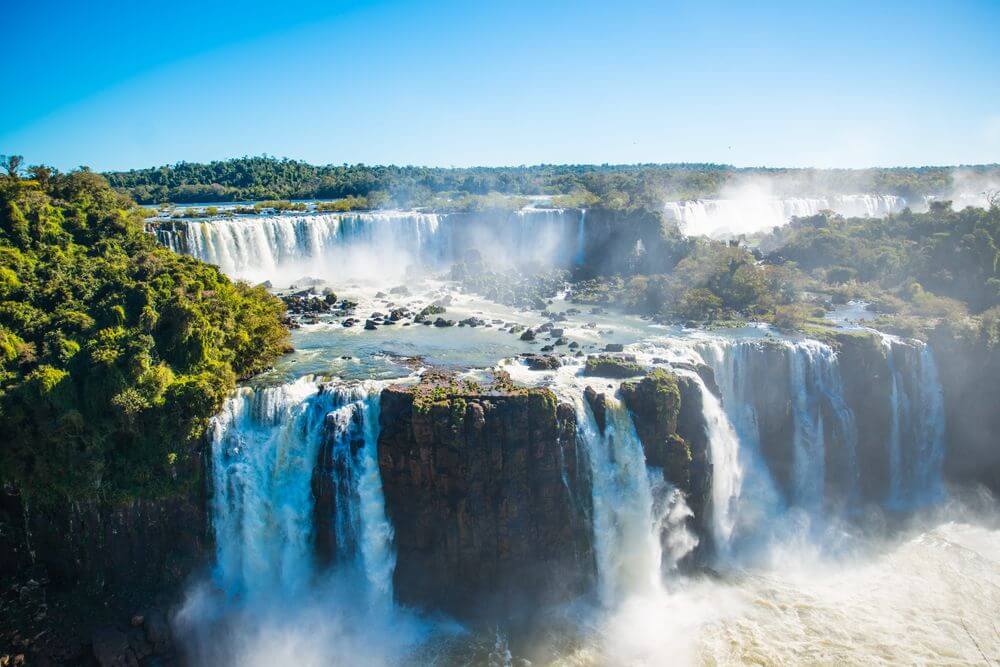
For those short on time, the Iguazu Falls can be reached with an easy 90 minute flight from Buenos Aires.
You’ll depart from Jorge Newbery domestic airport and arrive at Puerto Iguazu, the gateway city to Iguazu National Park and Iguazu Falls. We recommend booking the flight well in advance, particularly if you are travelling in the high season.
If you have more time and would like to travel through the countryside of Argentina, we can arrange a private transfer by car. Your driver can stop at interesting sites along the way, and you’ll break up the journey with an overnight stay.
Important information about visiting Iguazu National Park
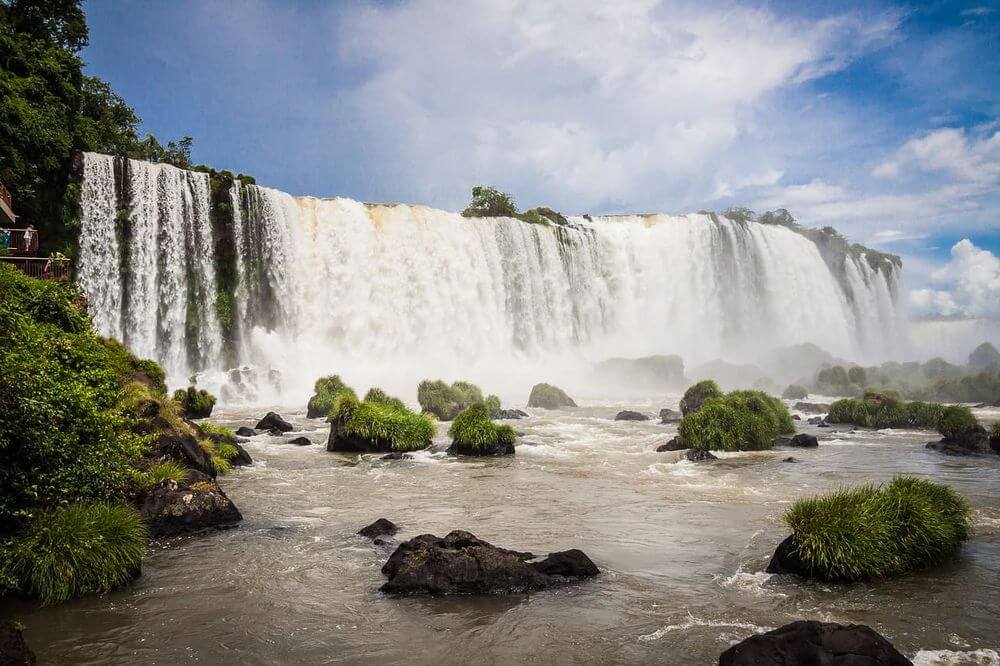
Discover the opening hours, ticket prices and park facilities to prepare for your visit to the Iguazu National Park and Iguazu Falls.
Opening hours
Argentina's Iguazu National Park is open every day of the year. You can enter the park between 8am and 4:30pm, and stay inside the park until 6pm.
Entrance fees
The entrance fee is 700 pesos for non-resident adults and 180 pesos for non-resident children. There is no charge for people with disabilities. You can pay in cash (only in pesos) or with a credit card.
If you are a resident of Argentina, Brazil, Paraguay, Uruguay or Venezuela, you will have a cheaper ticket price, although you must present your passport or national identification at the ticket office.
The cost includes access to the Lower and Upper Circuit, Devil’s Throat, ferry to San Martin Island, the Macuco Trail and Arrechea Waterfall, the Green Trail, the Nature Interpretation Centre and unlimited rides on the Ecological Jungle Train.
After your first day, be sure to revalidate your ticket at the ticket office, as this gives you a 50% discount on your second consecutive day at the park.
Facilities in Iguazu National Park
The park features accessible bathrooms, showers, ATMs, WIFI, mobile charging ports, a playground, a souvenir shop, first aid and ambulance service, and an information centre. You can hire lockers and strollers for babies from 0 to 2 years old.
There are plenty of places to eat within the park including La Selva restaurant and a number of fast food kiosks.
Things to do in Iguazu National Park
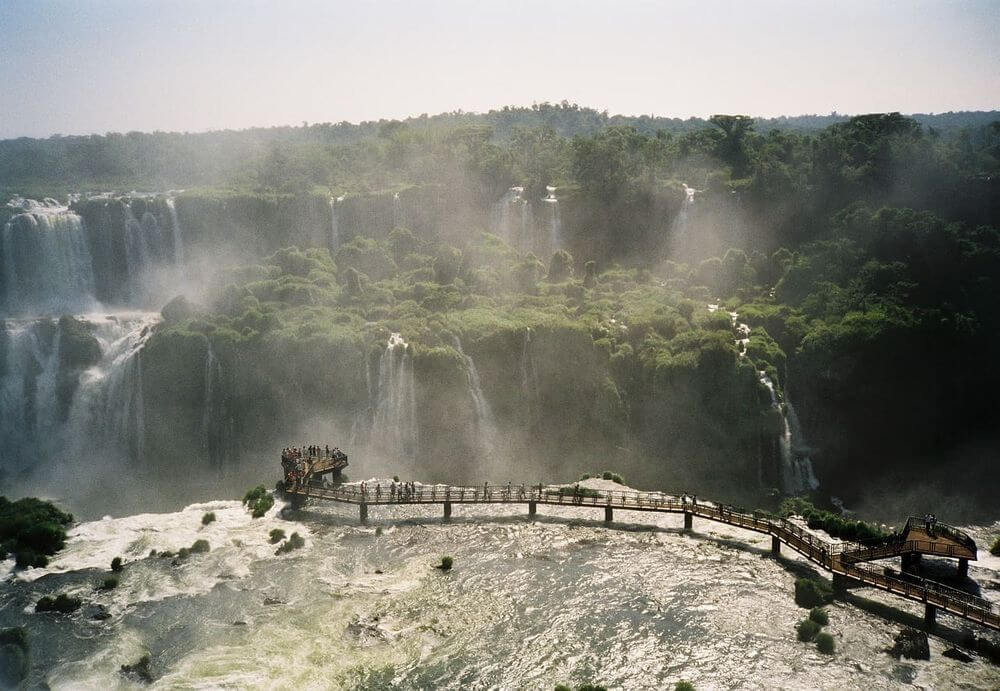
Iguazu National Park is full of treasures and exciting ways to experience the Iguazu Falls, with a myriad of different trails, viewpoints and activities. Here are ten of the best things to do in Iguazu National Park.
Ride the Ecological Jungle Train
Your entrance to Iguazu National Park includes unlimited rides on the ‘Green Train’, an ecological train circuit that takes you through the jungle and along the river, stopping at the main walking trails and Devil’s Throat.
Walk the Lower and Upper Circuit
These are the two main walking trails, offering breathtaking views of the falls. The Lower Circuit is a two kilometre system of walkways and challenging stairways, ingeniously designed to offer intimate encounters with the magical cascades, and spectacular views of the falls.
The Upper Circuit offers incredible panoramic views of the falls, and is best visited in the early morning or late afternoon to catch rainbows arcing through the spray.
Devil’s Throat
Known as La Garganta del Diablo (the Devil’s Throat), this monstrous waterfall is an unmissable highlight of the national park.
Take the Jungle Train to the Devil’s Throat station, then walk along a one kilometre catwalk, watching out for crocodiles and turtles in the water below. You’ll hear the ferocious power of this thundering waterfall before you see it, and it’s an stunning sight to witness.
Day trip to the Brazilian side of Iguazu Falls
Although two-thirds of the Iguazu Falls are on the Argentina side (and there’s more to see on the Argentina side), the Brazil side offers full-frontal, panoramic views of the falls and is well worth a day trip.
It can be difficult to navigate on your own, so we recommend taking a guided tour that includes hotel pick-ups and drop-offs, and a full-day experience within the falls, so you can make the most of your time.
It’s important to note that you may need a visa for Brazil, and you’ll need to arrange a visa prior to your trip, even if you are visiting just for the day.
San Martin Island
Head to San Martin Island for the best views of the magnificent San Martin waterfall. You can reach the island by taking a ferry from the Lower Circuit across to the island. The ferries are included in your entrance ticket and run every 15 minutes depending on the water levels.
You’ll reach a sandy beach where you’ll find the entrance to a trail that leads towards a circuit of viewpoints. The trail begins with a climb of around 170 stairs, but you’ll be rewarded with tremendous views of the San Martin waterfall, as well as a ring of other waterfalls including the famed Devil’s Throat and the Brazilian falls.
Be prepared to get soaked in the misty spray, as you stand face to face with this powerful force of nature. You may even see rainbows illuminated in the mist, and keep an eye out for unique bird species, lizards and hardy tree species.
Helicopter ride
A helicopter flight offers an incredible aerial perspective that shows just how enormous and powerful the Iguazu Falls really are. As you take to the air, you’ll be blown away by the view and it’s a wonderful opportunity to snap some impressive photos.
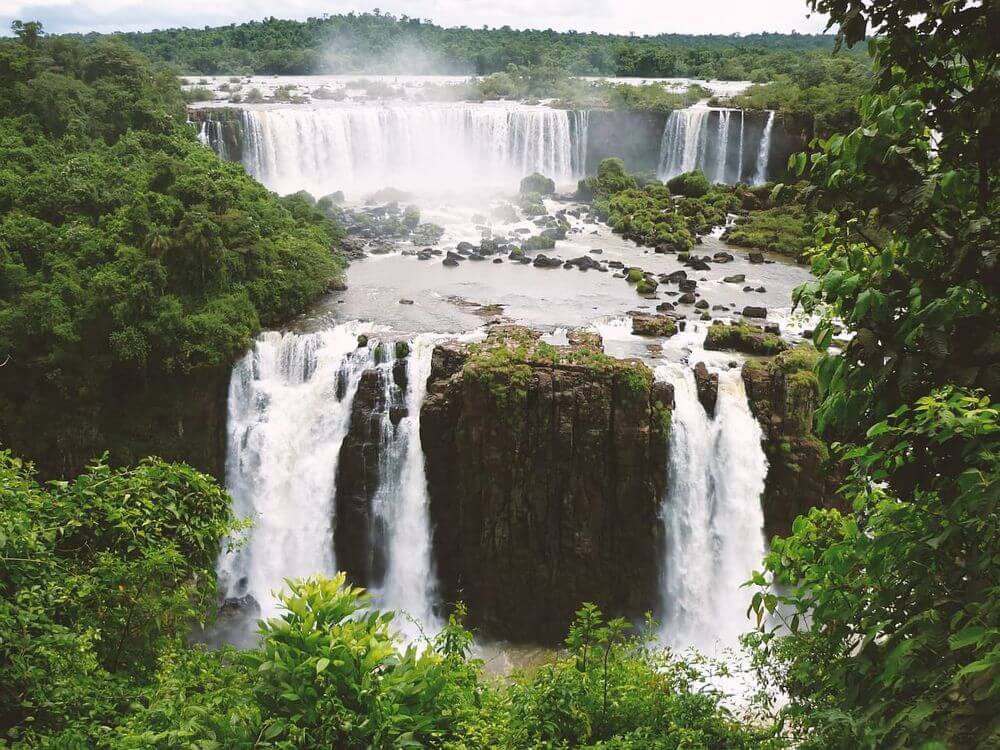
Hiking trails
Besides the Lower and Upper Circuit, there are a range of other fantastic hiking trails around the national park. The Macuco Trail and Arrechea Falls trail is a two-hour return hike through the jungle to Arrechea Waterfall, where you can swim and enjoy a picnic. Keep your eyes peeled for wildlife such as colourful insects and big groups of Caí monkeys.
Other great trails include the Green Trail and the Rainforest Trail. For maps, safety tips and more information, visit the Iguazu National Park website
Speedboat ride
Get up close and personal with the falls, by taking a boat ride into their watery depths. You’ll get drenched as you ride the churning rapids, and it’s an exhilarating way to get right under the falls. Depending on the season, the weather will be quite warm, but you’ll need to bring a change of clothes after your exciting ride.
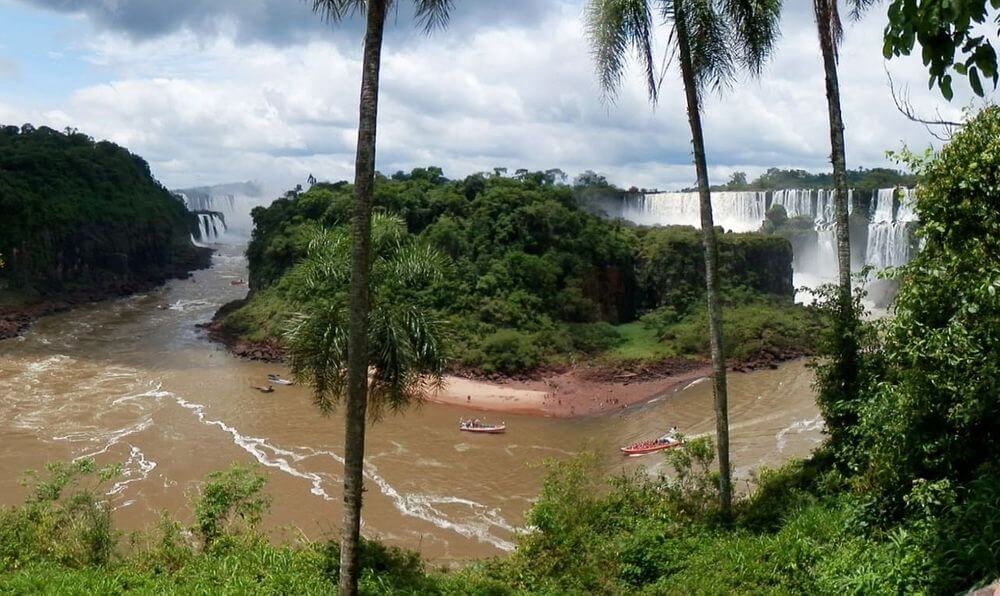
Jungle safaris
If you’d like to see all the incredible wildlife of the rainforest surrounding the falls, you can take a thrilling 4x4 jungle safari to spot howler monkeys, caymans, tapirs, giant anteaters, ocelots and even jaguars. There are also more than 2,000 species of plants to explore.
Guided tours of Iguazu Falls in Argentina
To maximise your time at Iguazu National Park, we recommend taking a guided tour that includes transport and entrance fees.
Your private guide will pick you up at your hotel, and take you to all the major sites of Iguazu National Park, including the Lower and Upper Circuits and Devil’s Throat.
As you wander through the jungle, your guide will point out fascinating plants, wildlife and gems of the jungle, while answering all your questions about the park. You’ll have the chance to see toucans, yellow-eyed bluebirds, monkeys and coatis (a cousin of the racoon).
Why we love it
The Iguazu Falls are like nothing on Earth. The sheer power, magnitude and beauty of the falls will blow you away, and even US First Lady, Eleanor Roosevelt, supposedly said Poor Niagara, after seeing the falls.
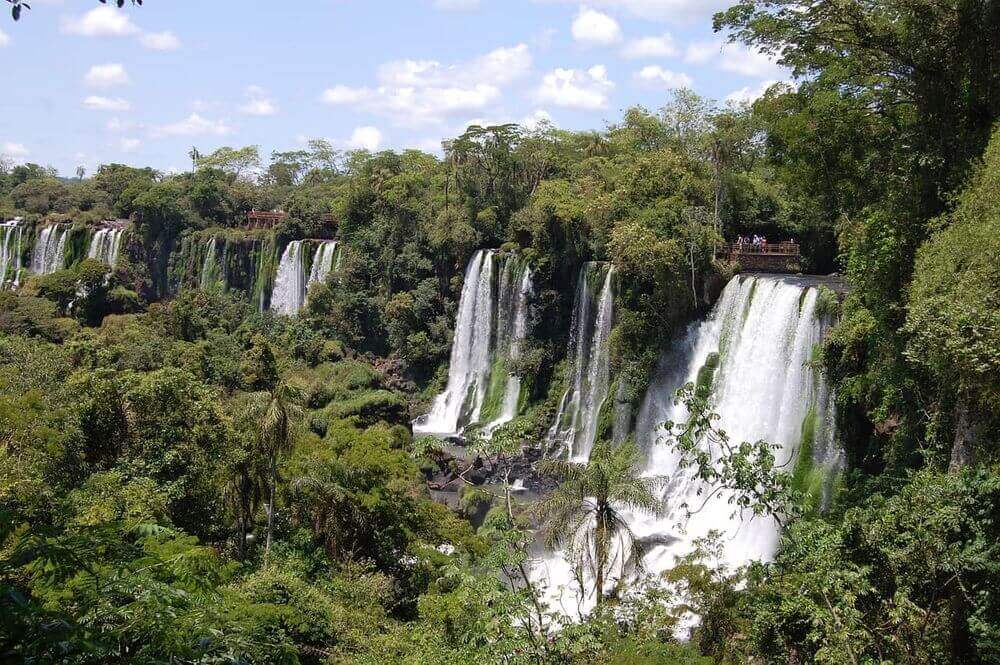
How much time should you spend at Iguazu Falls?
You’ll need at minimum of two nights in Puerto Iguazu to see everything at a relaxed pace, although we recommend spending three or four nights if you have time.
You’ll need an extra day if you’d like to spend a day on the Brazilian side of the falls.
Where to stay at Iguazu Falls in Argentina
For an immersive Iguazu experience, we recommend staying within the jungle, in close range of Iguazu National Park and Iguazu Falls.
Top hotels near Iguazu Falls:
Loi Suites
One of the best options is Loi Suites, a luxurious eco-lodge, set within the Iryapú Jungle, close to the Iguazu Falls. The lodge was built with a focus on sustainability and preservation of the native vegetation, and you’ll be surrounded by towering trees and incredible wildlife.
When you’re not exploring the jungle, you can enjoy the outdoor heated swimming pool, spa, pool bar, gym and an excellent restaurant.
Awasi Iguazu
We also recommend Awasi Iguazu, a lavish lodge set on the banks of the River Iguazu, located just 20 minutes from Iguazu Falls. Each villa is assigned a private driver and 4WD, so you can explore the surrounding Atlantic Rainforest at your own pace.
You’ll also enjoy customised culinary experiences, featuring fresh local produces, an open bar, and a fantastic selection of Argentinian wines.
Posada Puerto Bemberg
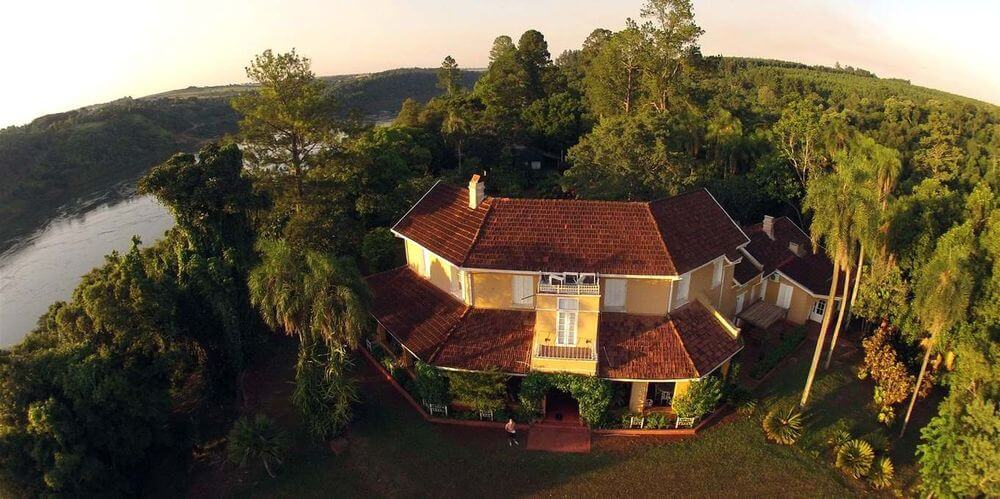
Posada Puerto Bemberg is another superb jungle lodge, located at the entrance of the Iguazu National Park. With incredible river views and access to exclusive jungle trails, you’ll be in a prime position to soak up the lush jungle, diverse wildlife and mighty Iguazu Falls.
Best time to visit Iguazu Falls
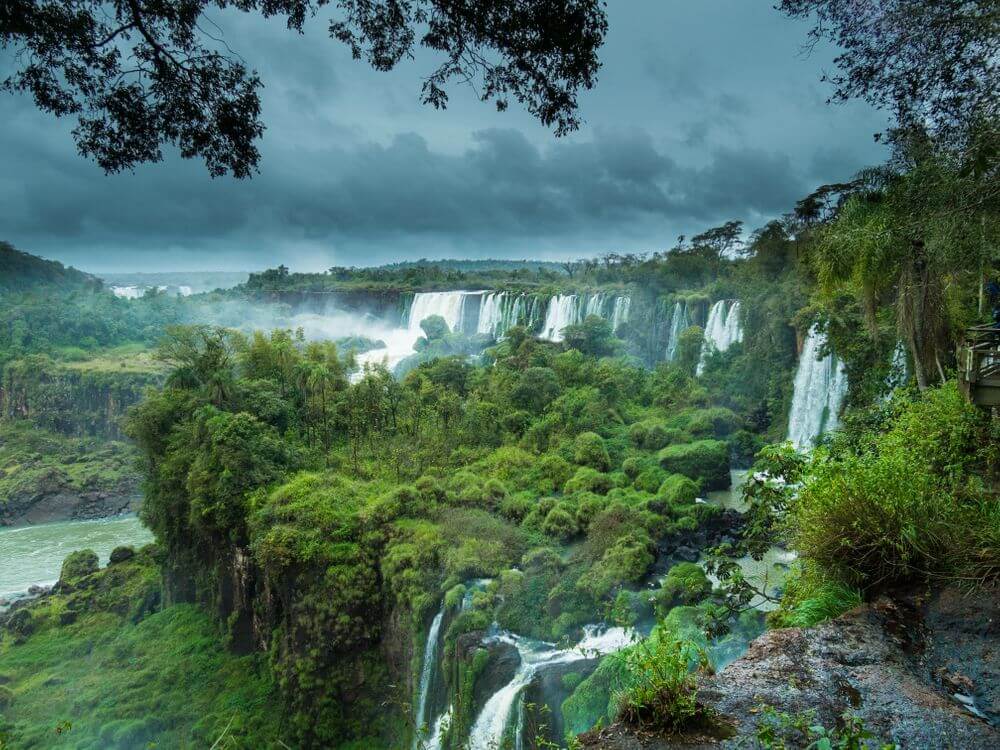
The Iguazu Falls changes throughout the year, depending on the season. If you’d like to see the waterfalls at their full, impressive force, the best time to visit is between December and February.
The rains are longer and heavier during these months, and the falls peak in volume, however the rain may also cause walking trails and San Martin Island to close.
December to February are also the hottest and busiest months, with soaring temperatures and crowds. The rain and heat brings humid conditions, although it’s also the best time to cool off under the falls with a thrilling boat ride.
The drier months of March to July bring blue skies, butterflies and rainbows shining through the spray. This a cooler period with less rain, and the water levels of the falls can decrease, so you won't see the full force of the waterfalls.
From August to September, the conditions are dry and cool, which is great for those wanting to hike or bike ride around the scenic trails of the national park. The falls won’t be at full volume, although the rain and heat starts to pick up again from October.
Iguazu National Park receives around 1.5 million visitors each year, averaging five to six thousand visitors each day in the low season, and around 10,000 visitors each day in the high season.
To avoid the largest crowds, steer clear of the high season from December to February, and the busy Easter holiday period around April.
For a month-by-month breakdown of weather and events in Puerto Iguazu and Argentina, read our in-depth When to Go to Argentina Guide.
What to pack for Iguazu Falls
- Comfortable walking shoes - sturdy, waterproof sandals are best, as the catwalks can get slippery and you’ll likely get wet.
- Hat and sunglasses
- Sun cream, insect repellent, bite relief cream and lip balm.
- Plastic ponchos or waterproof jacket to protect you from the spray.
- Small backpack or waterproof bag.
- Change of clothes and a small, quick-drying towel, if you’re planning on taking a boat ride.
- Refillable water bottle.
- Camera with plenty of memory.
Accessible Travel in Iguazu National Park
Argentina can be challenging when it comes to accessible travel, however the facilities at Iguazu National Park are excellent for those with limited mobility.
People with disabilities can enter the park free of charge and there is free transportation for the elderly and disabled. There are wheelchair accessible bathrooms, ramps running through the park that do not exceed a 6% slope, and footbridges equipped with protective mesh.
There's also an Ecological Jungle Train with an accessible carriage. The train runs a scenic 25-minute circuit through the national park, ending near Devil’s Throat. For more information about accessible travel in Argentina, read our in-depth Wayfairer Travel Guide to Argentina.
If you're interested in an Argentina holiday that includes Iguazu Falls, call our friendly team of Luxury Travel Specialists for a chat about your ideas or fill out our enquiry form with details of your dream Argentina trip.

